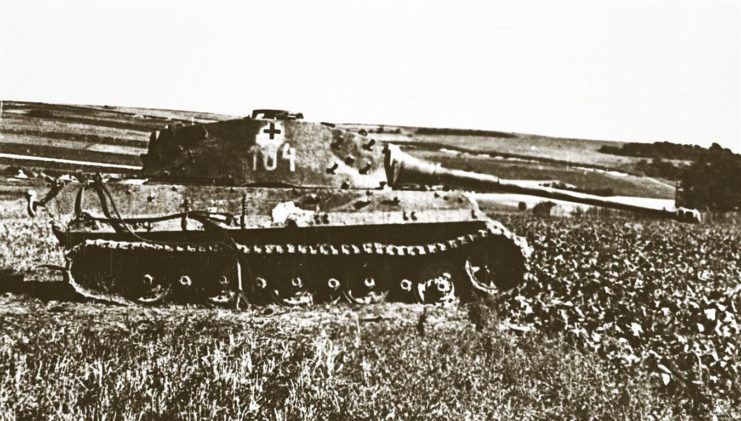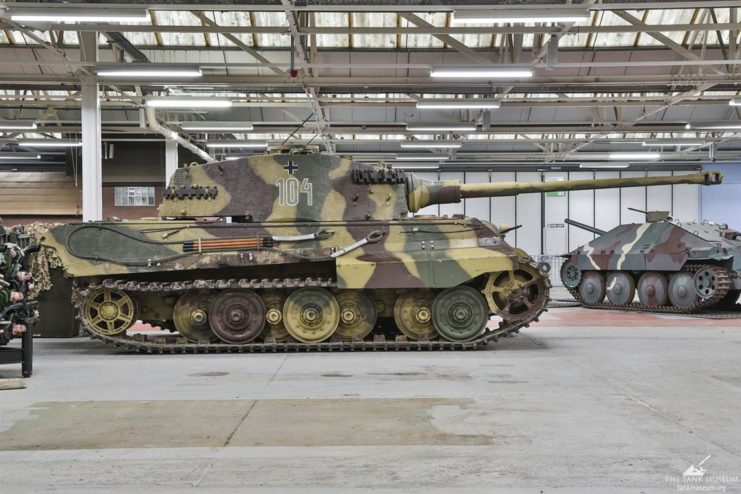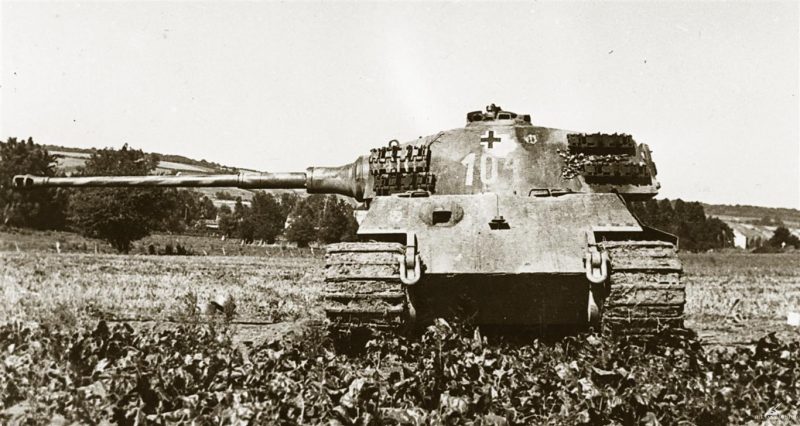The Tiger II with Production turret on display in the Tiger Collection was built in July 1944 by Henschel and given Fahrgestell Nummer (chassis number) 280093.
At the beginning of August it was one of 14 Tiger IIs issued to the 1st Company of SS Heavy Panzer Battalion 101 at Sennelager in Germany. Its turret number, 104, tells us it was one of two assigned to Company Headquarters, rather than being in one of the three Platoons of 4 tanks.
The tank was commanded by Oberscharfuhrer Sepp Franzl, the Kompanietruppfuhrer (Company Headquarters Section Leader). As well as serving as a tank commander he led the small administration element that supported the Company.
Abandoned
The Company travelled by rail into France and saw their first combat on the 23rd, counterattacking Allied forces that had begun to cross the River Seine. After just 14 days in action, the Company would have only one tank left.
As Allied forces poured across the Seine in ever increasing numbers the Germans in this part of France were forced to retreat North-East towards the Belgian border. They launched frequent counterattacks, often inflicting casualties, but never succeeding in stopping the Allied advance. This meant tanks that were damaged, broken down or out of fuel had to be abandoned to the Allies.
That appears to be what happened to this Tiger. It was abandoned on the 29th or 30th August. For many years this was believed to have occurred at Magny-en-Vexin roughly 8 miles North-East of the Seine. However recent study of wartime photographs of the tank and its surroundings by French historians has suggested that in fact it was abandoned at Aux Marais, a community on the outskirts of Beauvais around 15 miles further North-East.
23rd Hussars
It has also long been believed that this tank was fired on, possibly after it was abandoned, by the Sherman commanded by Sergeant Roberts of 4 Troop, A Squadron, 23rd Hussars.
The 23rd Hussars passed through Saint-Aubin-en-Bray, about 4 miles west of Aux Marais on the 30thAugust. They then advanced 70 miles through the night to take part in the capture of Amiens the next day.

The 23rd Hussars history, published in April 1946, records capturing an anti-aircraft site outside Amiens on the 31st August then, after this, Sergeant Roberts knocking out a Tiger II. However their War Diary, compiled closer to the time, mentions the anti-aircraft site, but not the Tiger II.
It is impossible now to be sure whether these events occurred as recorded, or whether the fog of war, made worse by the fatigue suffered by the Hussars on the night-time advance to Amiens, led to confusion over their exact date and location when they were recorded later.
What is clear is that tank 104 was shot at, although by whom is likely to remain unclear. There is damage on the right hand side of the hull in two locations. This can be seen on wartime photographs taken at Aux Marais. The Tiger was facing roughly south, so shots from the west, where the 23rd Hussars were, would have hit that side of the tank.

Sergeant Roberts himself was unable to clarify matters. Sergeant 7907199 Thomas Roberts MM was killed on the 5th January 1945 when his tank was knocked out near Bure in Belgium. He was 27.
After the battle the Tiger was recovered by the Royal Engineers in January 1945 and brought back to the UK. It was kept at the Fighting Vehicle Proving Establishment at Chertsey, then the Royal Military College at Shrivenham before coming to the Tank Museum in 2006.
Production of Tiger II
The Tiger Collection features two Tiger II’s: the Tiger II (Pre-Production) tank and the Tiger II (Production) tank. More powerful than Tiger I, it could destroy any Allied tank.
Tiger II or ‘Konigstiger’ (King Tiger) was first used during the Normandy campaign in 1944 and was the most powerful tank on the battlefield at that time. Despite its overwhelming superiority, the tank suffered from fuel shortages, technical problems and the bombing of factories meant too few were manufactured to have a real impact on the fighting.
When Henschel won the contract to build the Tiger II (VK4502 H), the armaments manufacturer Krupp designed the turret to fit both the Porsche and Henschel chassis. The initial design called P-2 Turm, mounted a single piece barrel 8.8 cm gun and had a curved mantlet.

A new design was ordered to fix a shot trap problem which had a two piece barrel. This design called Serien Turm, or commonly known as ‘Henschel’ or ‘Production’ turret, was to retain many features from the earlier turret when accepted for mass production.
The front curved was mantlet replaced with a single 180 mm armour plate sloped at 81 degrees. The sides were altered to slope at 69 degrees, and it could carry an additional 6 rounds or 22 belts of machine gun ammunition.
The Tiger II’s full combat weight was 68.5 tonnes when fitted with the earlier turret and 69.8 tonnes when fitted with the ‘Henschel’ turret. As part of an improvement programme, Tiger II’s engine was due to be upgraded to the more powerful Maybach 234 fuel injection engine.

The Tiger II in the exhibition, Panzerkampfwagen VI Ausf B (Sd Kfz 182), was issued to SS Panzer Battalion 101 and commanded by SS-Oberscharfuhrer Sepp Franzl. On 30th August 1944 the tank broke down at Magny-en-Vexin in northern France and was abandoned by its crew. From his Sherman tank, Sergeant Roberts of the 23rd Hussars then put two 75mm rounds into the left side above the track – damage which is still visible.
Crew: 5
Maximum Armour: 180 mm (7.1in)
Max sustained speed on road: 38 Km/h (23.6 mph)
Weight: 69.8 tonnes (68.7 Imp tons)
Weaponry: 8.8cm/88 mm KwK 43 main gun, 2 x 7.92 mm MG 34 machine guns
Range (on road): 170km (105.6 miles)
Fuel Capacity: 860L (189 Imp Gallon)
Service dates: 1944 – 1945
Manufacturer: Henschel and Sohn
A message from The Tank Museum:
“Please Support Us: As a charity, we rely on public support for all our activities. Our work is funded entirely by people like you. With your support, we can continue to create content. With the right support we might be able to do it more regularly – and can be even more ambitious. Please Click on the Banner Below.”
Thanks to the Tank Museum for this Blog, which originally appeared here and here.

